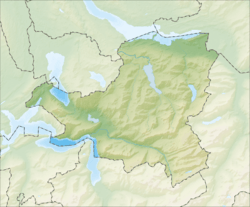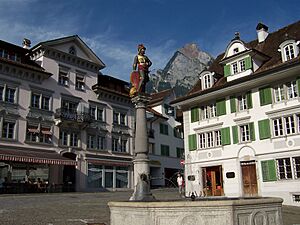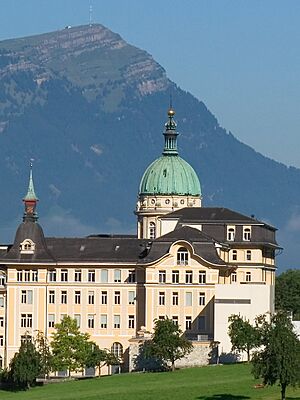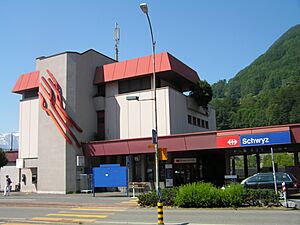Schwyz facts for kids
Quick facts for kids
Schwyz
|
||
|---|---|---|
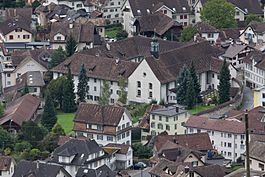 |
||
|
||
| Country | Switzerland | |
| Canton | Schwyz | |
| District | Schwyz | |
| Area | ||
| • Total | 53.18 km2 (20.53 sq mi) | |
| Elevation | 516 m (1,693 ft) | |
| Population
(Dec 2020 )
|
||
| • Total | 15,435 | |
| • Density | 290.24/km2 (751.72/sq mi) | |
| Postal code |
6430
|
|
| Localities | Schwyz, Ibach, Seewen, Rickenbach | |
| Surrounded by | Alpthal, Illgau, Ingenbohl, Lauerz, Morschach, Muotathal, Oberiberg, Rothenthurm, Sattel, Steinen | |
Schwyz (pronounced shveets) is an important town in Switzerland. It is the capital of the canton of Schwyz. A canton is like a state or a region within Switzerland.
Schwyz is famous because the Federal Charter of 1291 (also called the Bundesbrief) is kept here. This special document helped create Switzerland! You can see it at the Bundesbriefmuseum.
Most people in Schwyz speak a local type of Swiss German. This is a dialect of German.
Contents
- What's in a Name? The Story of Schwyz
- A Look Back: The History of Schwyz
- Exploring Schwyz: Geography and Nature
- Schwyz's Symbol: The Coat of Arms
- Who Lives in Schwyz? Population and People
- Important Places: Heritage Sites
- How Schwyz Works: Economy and Jobs
- Faith in Schwyz: Religion
- Learning in Schwyz: Education
- Weather in Schwyz
- Getting Around: Transport in Schwyz
- Famous Faces from Schwyz
- Images for kids
- See also
What's in a Name? The Story of Schwyz
The name "Schwyz" has a long history. It was first written down in the year 972 as villa Suittes. Over time, the spelling changed to Schwitz and then Schweitz.
For a long time, people thought the name came from a legendary founder named Suito or Switer. But today, experts are not sure where the name really comes from.
Some ideas suggest it might come from an old German word meaning "to burn." This could refer to how early settlers cleared forests for farming. Other ideas connect it to words about pigs or clearings in the forest.
The name Schwyz became so important that it was used for the whole area around the town. Eventually, it even became the name for the entire country of Switzerland! In the 1500s, people started using "Switzerland" (or Schwytzerland) and "Confederation" (Eidgenossenschaft) to mean the same country.
Even today, the way you say "Schwyz" for the town is the same as how you say "Switzerland" in Swiss German. The only difference is that you add "the" before "Switzerland."
A Look Back: The History of Schwyz
People have lived in the Schwyz area for a very long time. Some Roman coins have been found here. The first clear signs of a settlement are from the 700s. An old cemetery and a church from that time have been discovered.
Over the centuries, several churches were built in Schwyz. The first one was from the 700s. A later church, built around 1000, might have been destroyed by an earthquake. The current church, a beautiful Baroque building, was finished in 1774.
Since Schwyz was the capital of its canton, the town's history is very connected to the history of the whole canton.
In 1642, a big fire destroyed many buildings in the center of Schwyz. This allowed the town to be rebuilt with a new plan. A larger town square was created, with main roads spreading out from it. Houses were rebuilt in a more city-like style. Around the center, about 30 large, fancy farmhouses were built by important families.
Exploring Schwyz: Geography and Nature
The municipality of Schwyz includes the main town and smaller settlements like Ibach, Seewen, and Rickenbach. To the east, you can see impressive mountains like Kleiner Mythen and Grosser Mythen.
The Muota river flows through Schwyz on its way to Lake Lucerne. There are also mountain passes like Haggenegg Pass and Holzegg Pass that lead to other valleys.
About half of the land in Schwyz is used for farming. A large part is covered by forests. The rest is made up of buildings, roads, rivers, or mountains.
Schwyz's Symbol: The Coat of Arms
The coat of arms for Schwyz is red. It has a white cross that is cut off at one corner. This cross is a symbol of the Old Swiss Confederacy.
Who Lives in Schwyz? Population and People
Schwyz is home to over 15,000 people. Most people in Schwyz speak German as their main language. Other languages spoken include Serbo-Croatian and Italian.
About a quarter of the population are children and teenagers (under 20 years old). Most adults are between 20 and 64 years old.
Many people who live in Schwyz were also born there. Others moved from different parts of Switzerland or from other countries.
Important Places: Heritage Sites
Schwyz has many important historical buildings and places. These are called "heritage sites of national significance." They are very special and protected.
Some of these sites include:
- The Bundesbriefmuseum (Museum of the Swiss Charters of Confederation), where the founding document of Switzerland is kept.
- The Dominican nuns' Convent of St. Peter am Bach.
- The old town center, which shows how the settlement looked in medieval and early modern times.
- The Hermitage and its chapel.
- The Forum of Swiss History, a museum about Switzerland's past.
- Several historic houses, like the Ab Yberg im Grund House and the Bethlehem House.
- The Catholic Parish Church of St. Martin.
- The Rathaus (Town council house), where local government meets.
- The State Archives of Schwyz, which keeps important historical records.
How Schwyz Works: Economy and Jobs
Schwyz has a healthy economy. Many people work in different areas:
- Farming: Some people work in agriculture, like farming and forestry.
- Manufacturing and Construction: Many jobs are in making things (manufacturing) or building things (construction).
- Services: The largest number of jobs are in the service sector. This includes things like shops, hotels, restaurants, transportation, finance, and healthcare.
Many people who work in Schwyz travel there from other towns. This means Schwyz is a place where many jobs are available.
Faith in Schwyz: Religion
Most people in Schwyz are Roman Catholic. A smaller number belong to the Swiss Reformed Church or other Christian churches. There are also people who follow other religions like Islam or Orthodox Christianity. Some people do not belong to any church.
Learning in Schwyz: Education
Many people in Schwyz have completed higher education, like university or a technical college.
Schwyz has a public library called the Kantonsbibliothek Schwyz. It has over 100,000 books and other media for people to borrow.
A very important school in Schwyz is the Kantonsschule Kollegium Schwyz (KKS). This is a high school that also offers vocational training. The school has a long history, going back to a Latin school that opened in 1627. It has changed over the years, but it continues to provide education to students today.
Weather in Schwyz
Schwyz gets a good amount of rain each year. On average, it rains about 149 days a year. August is usually the wettest month, while February is the driest.
Getting Around: Transport in Schwyz
Schwyz is well-connected by roads. The A4 motorway, a major highway, passes near the town. Other main roads connect Schwyz to cities like Lucerne and to southern Switzerland.
The Schwyz railway station is about 2 kilometers (1.2 miles) outside the town. You can catch trains here to many places.
For a long time, from 1900 to 1963, Schwyz had trams that connected the railway station to the town center and to Brunnen. Now, buses have replaced the trams and operate many routes in the area.
There's also a gondola lift called the Rotenfluebahn. It takes you from Rickenbach up to the top of the Rotenfluh mountain. In summer, it's a great spot for views, and in winter, it's a ski area!
Famous Faces from Schwyz
Many notable people have come from Schwyz:
- Theodor von Reding (1755–1809): A Spanish general who led troops against Napoleon.
- Alois von Reding (1765–1818): A Swiss patriot and military officer, Theodor's brother.
- Carl Elsener Sr. (1922–2013): A Swiss business leader known for the Swiss Army knife.
- Xavier Koller (born 1944): A Swiss film director and writer.
- Gertrud Leutenegger (born 1948): A Swiss poet and writer.
- Monika Kaelin (born 1954): A model and actress.
- Sport
- Oscar Camenzind (born 1971): A former professional road racing cyclist.
- Luca Schuler (born 1998): A Swiss freestyle skier who competed in the Winter Olympics.
Images for kids
-
Catholic Parish Church of St. Martin with Kerchel and Heiligkreuz Chapel
See also
 In Spanish: Schwyz para niños
In Spanish: Schwyz para niños




